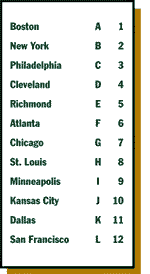|
|
Types of U.S. Paper Money
Currency in Circulation
More than 99 percent of the total dollar amount of paper money in circulation in the United States today is made up of Federal Reserve notes. The other small part of circulating currency consists of U.S. notes or legal tender notes still in circulation but no longer issued.
Federal Reserve notes are printed and issued in denominations of $1, $2, $5, $10, $20, $50, and $100. The $500, $1,000, $5,000, and $10,000 denominations have not been printed since 1946.
The Federal Reserve Act requires that adequate backing be pledged for all Federal Reserve notes in circulation. U.S. Treasury securities, acquired through open market operations, are the most important form of collateral and provide backing for most of the value of the currency in circulation. Some other types of collateral the Federal Reserve holds are gold certificates and certain eligible instruments such as notes, drafts, and bills of exchange.
 The Federal Reserve System, established by Congress in 1913, issues Federal Reserve notes through its 12 Federal Reserve Districts. Every district has its main office in a major city, and all but two have branches in other large cities. Each district is designated by a number and the corresponding letter of the alphabet, as shown at right. The Federal Reserve System, established by Congress in 1913, issues Federal Reserve notes through its 12 Federal Reserve Districts. Every district has its main office in a major city, and all but two have branches in other large cities. Each district is designated by a number and the corresponding letter of the alphabet, as shown at right.
The Bureau of Engraving and Printing, a division of the U.S. Treasury Department, produces currency for the Federal Reserve System to replace damaged or worn notes or to support economic growth. Federal Reserve Banks issue currency according to the need in their districts. The district letter and number on the face of a note identify the issuing Reserve Bank (see the diagram). A note with F6 on its face was issued by the Federal Reserve Bank of Atlanta, for example.
Types No Longer Issued
Besides the denominations of U.S. notes, from $1 to $10,000, that were issued before 1929, several other types of U.S. paper money no longer issued have circulated in this century. National Bank notes, for example, were issued by national banks from 1863 to 1929. Gold certificates, authorized in 1865 and issued by the Treasury Department in exchange for gold coin and bullion, circulated until 1933. Silver certificates, authorized in 1878 and issued in exchange for silver dollars, accounted for nearly all of the $1 notes in circulation until November 1963, when the first $1 Federal Reserve notes were issued.
|